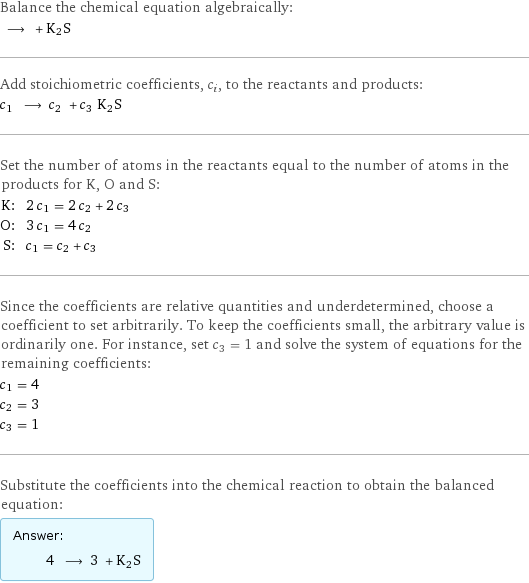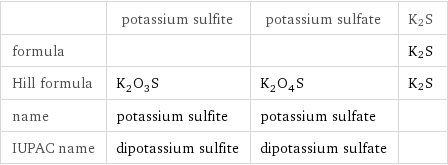Input interpretation

potassium sulfite ⟶ potassium sulfate + K2S
Balanced equation

Balance the chemical equation algebraically: ⟶ + K2S Add stoichiometric coefficients, c_i, to the reactants and products: c_1 ⟶ c_2 + c_3 K2S Set the number of atoms in the reactants equal to the number of atoms in the products for K, O and S: K: | 2 c_1 = 2 c_2 + 2 c_3 O: | 3 c_1 = 4 c_2 S: | c_1 = c_2 + c_3 Since the coefficients are relative quantities and underdetermined, choose a coefficient to set arbitrarily. To keep the coefficients small, the arbitrary value is ordinarily one. For instance, set c_3 = 1 and solve the system of equations for the remaining coefficients: c_1 = 4 c_2 = 3 c_3 = 1 Substitute the coefficients into the chemical reaction to obtain the balanced equation: Answer: | | 4 ⟶ 3 + K2S
Structures

⟶ + K2S
Names

potassium sulfite ⟶ potassium sulfate + K2S
Chemical names and formulas

| potassium sulfite | potassium sulfate | K2S formula | | | K2S Hill formula | K_2O_3S | K_2O_4S | K2S name | potassium sulfite | potassium sulfate | IUPAC name | dipotassium sulfite | dipotassium sulfate |
Substance properties

| potassium sulfite | potassium sulfate | K2S molar mass | 158.25 g/mol | 174.25 g/mol | 110.26 g/mol solubility in water | | soluble |
Units
